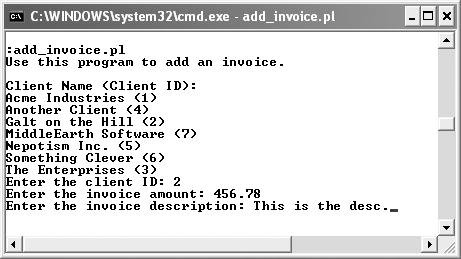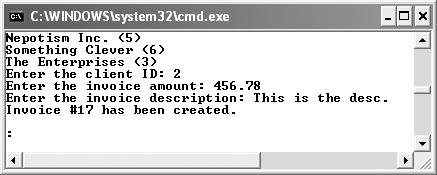$sth = $dbh->do ("INSERT INTO tablename (table_id, column) VALUES (NULL, 'value")
");
$insert_id = $dbh->{'mysql_insertid'}1. | Create a new Perl script in your text editor with the standard beginning lines of code (Script 8.5).
#!/usr/bin/perl -w
use strict;
use DBI; |
2. | Print some introductory text.
print "Use this program to add an invoice.\n\n";
print "Client Name (Client ID):\n"; |
| |
3. | Establish a connection to the database.
my $dbh = DBI->connect("DBI:mysql: accounting:localhost", 'username', 'password',
 {RaiseError => 1}); {RaiseError => 1});Script 8.5. This script retrieves the last automatically incremented value from the invoices table.
1 #!/usr/bin/perl -w
2
3 # Script 8.5 - add_invoice.pl
4 # This script adds an invoice to the
invoices table.
5 # It relies upon user input.
6
7 # Use what needs to be used.
8 use strict;
9 use DBI;
10
11 # Print a message.
12 print "Use this program to add an
invoice.\n\n";
13 print "Client Name (Client ID):\n";
14
15 # Connect to the database.
16 my $dbh = DBI->connect("DBI:mysql:
accounting:localhost", 'username',
'password', {RaiseError => 1});
17
18 # Show the current clients with their
IDs.
19 my $sql = "SELECT client_name, client_id
FROM clients ORDER BY client_name ASC";
20
21 # Query the database.
22 my $sth = $dbh->prepare($sql);
23
24 if (defined($sth)) {
25 $sth->execute();
26 my @row;
27 while (@row = $sth->fetchrow_array())
{
28 print "$row[0] ($row[1])\n";
29 }
30 }
31 $sth->finish();
32
33 # Get the information from the user.
34 print "Enter the client ID: ";
35 my $client_id = <STDIN>;
36 print "Enter the invoice amount: ";
37 my $amount = <STDIN>;
38 print "Enter the invoice description: ";
39 my $desc = <STDIN>;
40
41 # Query the database.
42 $sql = "INSERT INTO invoices (client_id,
invoice_amount, invoice_description)
VALUES ($client_id, $amount, '$desc')";
43 my $affected= $dbh->do($sql);
44
45 # Report on the success of the query
attempt.
46 if ($affected== 1) {
47 print "Invoice #" . $dbh->
{'mysql_insertid'} . " has been
created.\n";
48 } else {
49 print "The invoice could not be
created! \n";
50 }
51
52 # Disconnect.
53 $dbh->disconnect;
|
|
4. | List the current clients with their client IDs.
my $sql = "SELECT client_name, client_id FROM clients ORDER BY client_name ASC";
my $sth = $dbh->prepare($sql);
if (defined($sth)) {
$sth->execute();
my @row;
while (@row = $sth-> fetchrow_array()) {
print "$row[0] ($row[1])\n";
}
}
$sth->finish();
The code to this point is exactly like that in add_user.pl.
|
5. | Prompt for the client's ID, the invoice amount, and the invoice description.
print "Enter the client ID: ";
my $client_id = <STDIN>;
print "Enter the invoice amount: ";
my $amount = <STDIN>;
print "Enter the invoice description: ";
my $desc = <STDIN>;
This script will prompt for three things ( Figure 8.24): the client's ID, the invoice amount, and the invoice description. These correspond to the fields in the invoices table. Along with these fields, the table also has an invoice ID, which will be automatically generated, an invoice date, which will be automatically set as the current date (because it's a TIMESTAMP type), and the date_invoice_paid date.

|
| |
6. | Create the INSERT query and send it to the database.
$sql = "INSERT INTO invoices (client_id, invoice_amount, invoice_description) VALUES
 ($client_id, $amount, '$desc')";
my $affected= $dbh->do($sql); ($client_id, $amount, '$desc')";
my $affected= $dbh->do($sql);
Nothing new here. You could do some validation on the submitted data before using it in a query, though.
|
7. | Print a message indicating the success of the query.
if ($affected== 1) {
print "Invoice #" .$dbh->{'mysql_insertid'} . " has been created.\n";
} else {
print "The invoice could not be created! \n";
}
Now, if the invoice is created in the database, the invoice ID is returned by calling
$dbh->{'mysql_insertid'}. |
8. | Close the database connection.
|
9. | Save the file as add_invoice.pl, change the permissions (if necessary), and run the script ( Figure 8.25).

|
 Js editor
Website development
Js editor
Website development
 Js editor
Website development
Js editor
Website development